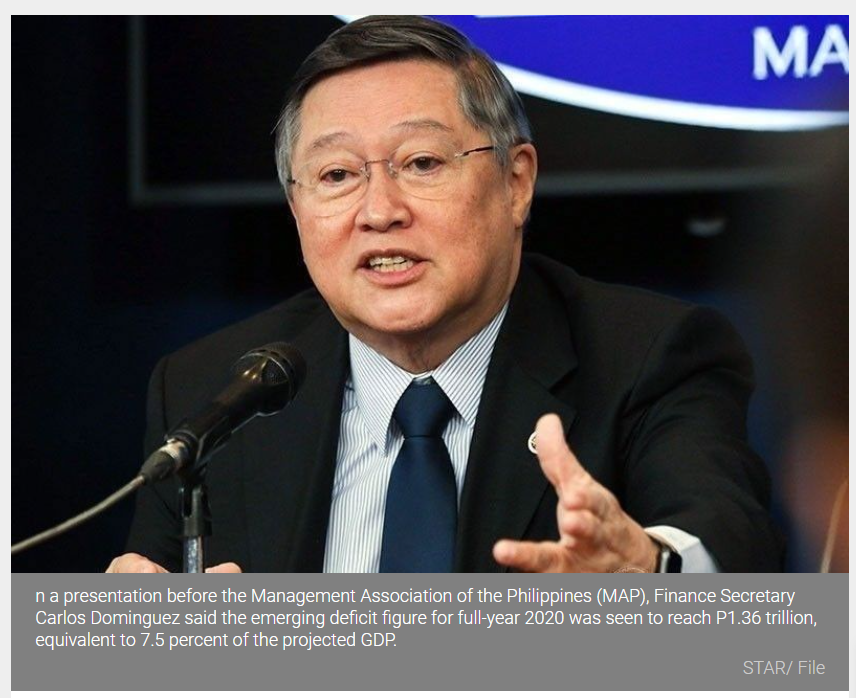Philippines: Deficit to GDP reaches 7.5% in 2020
MANILA, Philippines — The country’s fiscal deficit ballooned to 7.5 percent of gross domestic product in 2020, but settled slightly lower than the government’s forecast as both revenues and expenditures went below their revised targets, according to the Department of Finance (DOF).
In a presentation before the Management Association of the Philippines (MAP), Finance Secretary Carlos Dominguez said the emerging deficit figure for full-year 2020 was seen to reach P1.36 trillion, equivalent to 7.5 percent of the projected GDP.
The 2020 shortfall was more than double the P660.24 billion deficit recorded in 2019, which was equivalent to 3.4 percent of GDP.
However, this was slightly lower than the adjusted Development Budget Coordination Committee (DBCC) ceiling of P1.38 trillion or 7.6 percent of GDP for 2020.
“Despite the large increase, we expect our deficit-to-GDP ratio to remain within the median of our neighbors and credit-rating peers around the world. We have made sure that the size of our deficit still takes into consideration our adherence to long-term debt sustainability,” Dominguez said.
According to the finance chief, the national government raised P2.84 trillion in revenues last year, slightly lower than the revised target set by the DBCC amounting to P2.85 trillion.
On the other hand, disbursements amounted to P4.205 trillion, about 0.66 percent lower than the DBCC projection of P4.23 trillion, but 11 percent higher than the previous year’s P3.8 trillion.
“This includes the spending mandated under Bayanihan 1 and 2, as well as the continuation of the key infrastructure projects we are banking on to support economic recovery,” Dominguez said.
To bridge the higher deficit brought about by the COVID-19 pandemic, Dominguez said the government needed to ramp up its borrowings.
For 2020, he said the government’s debt-to-GDP ratio was projected to reach 53.5 percent, lower than the DBCC forecast of 53.9 percent. This was, however, much higher than the 39.6 percent level posted in 2019.
“Nevertheless, this level kept us well within the prescribed bounds of fiscal viability,” Dominguez said.
He said the total gross financing incurred by the government last year amounted to P2.63 trillion, more than 2.5 times higher than the P1.02 trillion raised in 2019. This does not include the P540 billion emergency short-term loan extended by the Bangko Sentral ng Pilipinas which was re-paid in December and re-availed this year.
About P1.91 trillion of the total amount was raised from the issuance of government securities in the domestic market. Another P403.1 billion came from official development assistance, while P318.1 billion was sourced from the sale of global bonds in the offshore market, particularly the US and Europe.
“This year, the Philippines will maintain an elevated but manageable deficit program of 8.9 percent behind the need for strong government fiscal support in restarting the economy,” Dominguez said.
The gross financing is programmed to reach P3.03 trillion, which is expected to result in a debt-to-GDP ratio of 57 percent this year.
“Even with the upscaling of our borrowing plan, we would still be able to keep our debt ratio within a sustainable threshold. This gives us the advantage over economies who were already saddled with heavy debt prior to the crisis,” Dominguez said. “We remain confident that we can easily fulfill our funding requirements for this year.”
Source: https://www.philstar.com/business/2021/01/14/2070208/deficit-gdp-reaches-75-2020


 Thailand
Thailand




